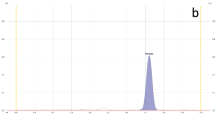Abstract
Yohimbine is the major alkaloid found in the stem bark of yohimbe, Pausinystalia johimbe (Rubiaceae), an evergreen tree native to Africa. The objectives of the current study were to provide a detailed anatomy of yohimbe bark, as well as to determine the quantity of yohimbine in the raw yohimbe products sold online. Twelve commercial raw materials of yohimbe were analyzed by microscopic and ultra performance liquid chromatography–UV–MS methods. The study revealed that three samples were probably adulterated and four other samples contained various levels of impurities. Yohimbine was not detected in one sample, whereas its presence in other samples was found to be in the range 0.1–0.91%. The present work also provides a detailed anatomy of the stem bark of yohimbe, with light and scanning electron microscopy images, for proper identification and authentication.






Similar content being viewed by others
References
Blumenthal M, Lindstrom A, Lynch ME, Rea P (2011) Herb sales continue growth-up 3.3% in 2010. Herbalgram 90:64–67
Orwa C, Mutua A, Kindt R, Jamnadass R, Anthony S (2009) Agroforestree database: a tree reference and selection guide, version 4.0. http://www.worldagroforestry.org/sites/treedbs/treedatabases.asp
Mills S, Bone K (2000) Principles and practice of phytotherapy. Churchill Livingstone, London
Schwartz S (2005) Psychoactive herbs in veterinary behavior medicine. Blackwell, Oxford
Khan IA, Abourashed EA (2010) Leung’s encyclopedia of common natural ingredients used in food, drugs and cosmetics. Wiley, Hoboken
Gurib-Fakim A (2006) Medicinal plants: traditions of yesterday and drugs of tomorrow. Mol Aspects Med 27:1–93
Small J, Adams F (1922) Yohimbe bark: its history and identification in commerce. Pharma J 108:266, 282–265, 311–264
Upton R, Graff A, Jolliffe G, Langer R, Williamson E (eds) (2011) American herbal pharmacopoeia: botanical pharmacognosy—microscopic characterization of botanical medicines. CRC, Boca Raton
Betz JM, White KD, der Marderosian AH (1995) Gas chromatographic determination of yohimbine in commercial yohimbe products. J AOAC Int 78:1189–1194
Li K, Zhang Z, Chen C, Li P (2008) Extraction of total alkaloids from bark of Corynanthe yohimbe and GC–MS analysis on its chemical components. Zhongcaoyao 39:1146–1147
Doxey JC, Lane AC, Roach AG, Virdee NK (1984) Comparison of the alpha-adrenoceptor antagonist profiles of idazoxan (RX 781094), yohimbine, rauwolscine and corynanthine. Naunyn-Schmiedeberg’s Arch Pharmacol 325:136–144
Kohli JD, De NN (1956) Pharmacological action of rauwolscine. Nature (London, UK) 177:1182
Chen Q, Li P, Zhang Z, Li K, Liu J, Li Q (2008) Analysis of yohimbine alkaloid from Pausinystalia yohimbe by non-aqueous capillary electrophoresis and gas chromatography–mass spectrometry. J Sep Sci 31:2211–2218
Singh A, Alvi NI (2011) High-performance thin-layer chromatographic quantification of yohimbine in the stem bark of Pausinystalia yohimbe. J Planar Chromatogr Mod TLC 24:253–256
El Gindy AE, Farouk M, Abd El Aziz L, Shokry ES (2009) Stability indicating assay of yohimbine hydrochloride using high performance liquid chromatography. J Appl Sci Res 5:693–698
Zanolari B, Ndjoko K, Ioset J-R, Marston A, Hostettmann K (2003) Qualitative and quantitative determination of yohimbine in authentic yohimbe bark and in commercial aphrodisiacs by HPLC-UV-API/MS methods. Phytochem Anal 14:193–201
Mittal S, Alexander KS, Dollimore D (2000) A high-performance liquid chromatography assay for yohimbine-HCl analysis. Drug Dev Ind Pharm 26:1059–1065
Diquet B, Doare L, Gaudel G (1984) New method for the determination of yohimbine in biological fluids by high-performance liquid chromatography with amperometric detection. J Chromatogr Biomed Appl 311:449–455
Pietsch J, Guenther J, Henle T, Dressler J (2008) Simultaneous determination of thirteen plant alkaloids in a human specimen by SPE and HPLC. J Sep Sci 31:2410–2416
Knych HKD, Steffey EP, Deuel JL, Shepard RA, Stanley SD (2011) Pharmacokinetics of yohimbine following intravenous administration to horses. J Vet Pharmacol Ther 34:58–63
Reimer G, Suarez A, Chui YC (1993) A liquid chromatographic procedure for the analysis of yohimbine in equine serum and urine. J Anal Toxicol 17:178–181
Goldberg MR, Speier L, Robertson D (1984) Assay of yohimbine in human plasma using high performance liquid chromatography with electrochemical detection. J Liq Chromatogr 7:1003–1012
Owen JA, Nakatsu SL, Condra M, Surridge DH, Fenemore J, Morales A (1985) Sub-nanogram analysis of yohimbine and related compounds by high-performance liquid chromatography. J Chromatogr Biomed Appl 342:333–340
Zhang Y, Huang Z, Ding L, Yan H, Wang M, Zhu S (2010) Simultaneous determination of yohimbine, sildenafil, vardenafil and tadalafil in dietary supplements using high-performance liquid chromatography–tandem mass spectrometry. J Sep Sci 33:2109–2114
Schaneberg BT, Khan IA (2004) Quantitative and qualitative HPLC analysis of thermogenic weight loss products. Pharmazie 59:819–823
Aucelio RQ, Campiglia AD (1995) Solid surface room temperature phosphorimetry analysis of yohimbine hydrochloride in pharmaceutical formulations. Anal Chim Acta 309:345–353
Chamberlain CJ (1901) Methods in plant histology. University of Chicago Press, Chicago
Ruzin SE (1999) Plant microtechnique and microscopy. Oxford University Press, New York
Hayat MA (2000) Principles and techniques of electron microscopy: biological applications. Cambridge University Press, Cambridge
Acknowledgments
This research is supported in part by Science Based Authentication of Dietary Supplements and Botanical Dietary Supplement Research, funded by the Food and Drug Administration (grant no. 1U01FD004246-01); the United States Department of Agriculture, Agricultural Research Service, Specific Cooperative Agreement (no. 58-6408-2-0009); the Global Research Network for Medicinal Plants (GRNMP), King Saud University.
Author information
Authors and Affiliations
Corresponding author
Rights and permissions
About this article
Cite this article
Raman, V., Avula, B., Galal, A.M. et al. Microscopic and UPLC–UV–MS analyses of authentic and commercial yohimbe (Pausinystalia johimbe) bark samples. J Nat Med 67, 42–50 (2013). https://doi.org/10.1007/s11418-012-0642-2
Received:
Accepted:
Published:
Issue Date:
DOI: https://doi.org/10.1007/s11418-012-0642-2




